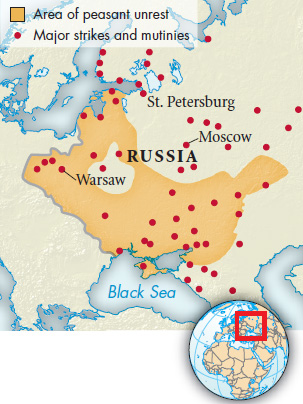A History of Western Society: Printed Page 765
A History of Western Society, Value Edition: Printed Page 774
The Russian Revolution of 1905
Catching up partly meant further territorial expansion, for this was the age of Western imperialism. By 1903 Russia had established a sphere of influence in Chinese Manchuria and was eyeing northern Korea, which put Russia in conflict with the goals of an equally imperialistic Japan. When Tsar Nicholas II (r. 1894–1917), who replaced his father in 1894, ignored their diplomatic protests, the Japanese launched a surprise attack in February 1904. After Japan scored repeated victories, which included annihilating a Russian fleet, Russia surrendered in September 1905.
Once again, military disaster abroad brought political upheaval at home. The business and professional classes had long wanted a liberal, representative government. Urban factory workers were organized in a radical and still-illegal labor movement. Peasants had gained little from the era of reforms and suffered from poverty and overpopulation. At the same time, the empire’s minorities and subject nationalities, such as the Poles, the Ukrainians, and the Latvians, continued to call for self-rule. With the army pinned down in Manchuria, all these currents of discontent converged in the revolution of 1905.

On a Sunday in January 1905, a massive crowd of workers and their families converged peacefully on the Winter Palace in St. Petersburg to present a petition to Nicholas II. Suddenly troops opened fire, killing and wounding hundreds. The Bloody Sunday massacre produced a wave of general indignation that turned many Russians against the tsar. (See “Primary Source 23.2: Eyewitness Accounts of Bloody Sunday.”)
By the summer of 1905 strikes and political rallies, peasant uprisings, revolts among minority nationalities, and mutinies by troops were sweeping the country. The revolutionary surge culminated in October 1905 in a paralyzing general strike that forced the government to capitulate. The tsar then issued the October Manifesto, which granted full civil rights and promised a popularly elected Duma (or parliament) with real legislative power. The manifesto split the opposition. Frightened middle-class leaders embraced it, which helped the government repress the popular uprising and survive as a constitutional monarchy.
On the eve of the opening of the first Duma in May 1906, the government issued the new constitution, the Fundamental Laws. The tsar retained great powers. The Duma, elected indirectly by universal male suffrage with a largely appointive upper house, could debate and pass laws, but the tsar had an absolute veto. As in Bismarck’s Germany, the tsar appointed his ministers, who did not need to command a majority in the Duma.
The predominantly middle-class liberals, the largest group in the newly elected Duma, saw the Fundamental Laws as a step backward. Cooperation with Nicholas II’s ministers soon broke down, and after months of deadlock the tsar dismissed the Duma. Thereupon he and his reactionary advisers unilaterally rewrote the electoral law, increasing greatly the weight of the conservative propertied classes. When new elections were held, the tsar could count on a loyal legislative majority. His government then pushed through important agrarian reforms designed to break down collective village ownership of land and encourage the more enterprising peasants — a “wager on the strong” meant to encourage economic growth. In 1914, on the eve of the First World War, Russia was partially modernized, a conservative constitutional monarchy with a peasant-based but industrializing economy.